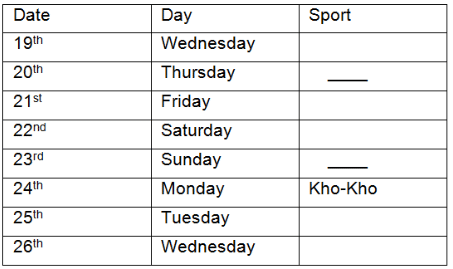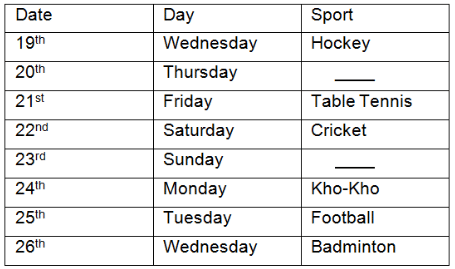Test: PU LLB Mock Test - 7 (New Pattern) - CLAT MCQ
30 Questions MCQ Test - Test: PU LLB Mock Test - 7 (New Pattern)
In which of the following years did The American Revolutionary War end?
Netaji Subhash Chandra Bose International Airport is in which city?
Which article provides Freedom of speech and expression?
What was the primary focus of the Kasturirangan Committee when it was established in 2012?
Which organizations collaborated in the development of the Astra missile?
Which of the following best describes Other Effective Area-based Conservation Measures (OECMs)?
What financial support is provided to interns under the PM Internship Scheme?
What has the Supreme Court mandated regarding the reassessment of the OBC list in West Bengal?
What is the primary purpose of Flue Gas Desulphurisation (FGD) technology in coal-fired power plants?
Directions: In this question, one or more principles are given followed by some facts. Read the principle(s) carefully and apply it/them to the given facts and choose the most appropriate option.
Principle: If a person, without any authority, prevents a person to proceed to any direction and is kept confined, he commits an offence of criminal confinement.
Facts: The Municipal Board allowed X to hold a marriage party by blocking a part of a public road. The marriage party blocked most of the road and did not allow A, a passerby, to cross the road. He brought a charge of criminal confinement against the head of the marriage party and other associates.
Can A succeed?
Directions: In this question, one or more principles are given followed by some facts. Read the principle(s) carefully and apply it/them to the given facts and choose the most appropriate option.
Principle: A surety is discharged if the creditor and the principal debtor vary the terms of the contract without his consent.
Facts: Vikash agrees to act as a guarantor for Shubham's employment as a clerk to Shivani. Later, Shubham was promoted as a financial head by Shivani. One day, Shubham stole money and left the country. Shivani decided to sue Vikash.
Decide his liability.
Directions: In this question, one or more principles are given followed by some facts. Read the principle(s) carefully and apply it/them to the given facts and choose the most appropriate option.
Principle: A minor's agreement is absolutely void.
Facts: Sumit, aged 14, is a stamp collector. He is particularly anxious to get a rare stamp of Rani Laxmibai belonging to Prakash, who agrees in writing to sell it to Sumit for Rs. 1000. He subsequently refuses to deliver it to Sumit, though Sumit has already paid Rs. 1000 to him. Sumit now wants to sue Prakash.
Will he succeed?
Directions: Given below is a statement of principle followed by facts. Apply the principle to the facts given below and select the most appropriate answer.
Principle: An occupier should not do a dangerous act without an adequate warning.
Facts: 'A' was cutting a large tree on his land. Some boys were playing nearby. 'A' paid no attention and the tree fell, one of the boys was hit by a branch and suffered injury.
The cardinal principle of criminal law "Nullum crimen nulla poena sine lege" means:
Which Article of the Third Geneva Convention of 1949 defines the prisoners of War?
The Universal Declaration of Human Rights was adopted on
The Universal Declaration of Human Rights was adopted by the third General Assembly of the United Nations on December 10, 1948 in Paris.
Which of the following commissions was appointed for creation of new states on the basis of language?
Which one of the following Schedules of the Constitution of India contains provisions regarding anti-defection?
Which article of the Constitution of India provides constitutional safeguards to the civil servants?
Directions: In the following question, the two words given to the left of sign (: :) bear a certain relationship to each other. The same relationship exists between the two words to its right, one of which is missing. Find the missing word from the given alternatives.
Nile : River : : Pacific : ?
Directions: In the following question, the two words given to the left of sign (: :) bear a certain relationship to each other. The same relationship exists between the two words to its right, one of which is missing. Find the missing word from the given alternatives.
Umbrella : Rain : : Sweater : ?
Directions: Fill in the blank with the suitable preposition.
Are you familiar ___________ the habits of your son?
Directions: In the following question, choose the word which best fills the blank from the four given options.
The food grain stocks in India are at an all-time ________.
Direction: Read the following information carefully and answer the given question.
The sports week of a college was organized from 19th to 26th of a month, 19th being Wednesday. During that period, six games Cricket (C), Badminton (B), Table Tennis (T), Kho-Kho (K), Hockey (H), and Football (F) were played, one game on each day.
(1) Hockey was not played on the closing day, i.e. 26th.
(2) Table Tennis was played just one day before Cricket was played.
(3) Football was not played on either Wednesday or Saturday.
(4) No game was played on Thursday and Sunday.
(5) Kho-Kho was played on Monday.
(6) There was a gap of two days between Cricket and Football.
Q. How many days gap is there between Hockey and Football?
Direction: Read the following passage and answer the question that follows:
Asia's importance to Canada has become increasingly evident, particularly with regard to investment from China, patterns of migration and cultural exchange, and the need to cooperate on global problems such as climate change. The rising economies in Asia translate into Asian countries having a greater say in the rules that determine global trade, the global financial system and global security. Asia's rise will have a significant impact on global economic and political dynamics, as well as influence on the arts, culture and innovation of the world. Canada must determine what the future of its engagement with Asia will be.
While Canadians may understand the role of Asia in Canada's history and multicultural communities, their current views on the region are unclear and many Canadians view Asia guardedly. In 2010, the Asia Pacific Foundation of Canada polled Canadians about their opinions concerning Asia. The results showed that Canadians recognized Asia's strength during the post-recession recovery, with 62% agreeing that closer engagement with Asia is necessary for the country's future prosperity. Poll respondents also acknowledged the need for businesses and the government to focus their attention on Asia.
Despite this awareness, only 29% of respondents consider Canada part of the Asia Pacific region and remain wary of embracing China, even as they acknowledge its growing power. Canadians were more favorable towards India's economic and political rise, viewing India as less threatening socially and militarily.
Q. According to the passage, what was the purpose of conducting the polls?
Direction: Read the following passage and answer the question that follows:
Asia's importance to Canada has become increasingly evident, particularly with regard to investment from China, patterns of migration and cultural exchange, and the need to cooperate on global problems such as climate change. The rising economies in Asia translate into Asian countries having a greater say in the rules that determine global trade, the global financial system and global security. Asia's rise will have a significant impact on global economic and political dynamics, as well as influence on the arts, culture and innovation of the world. Canada must determine what the future of its engagement with Asia will be.
While Canadians may understand the role of Asia in Canada's history and multicultural communities, their current views on the region are unclear and many Canadians view Asia guardedly. In 2010, the Asia Pacific Foundation of Canada polled Canadians about their opinions concerning Asia. The results showed that Canadians recognized Asia's strength during the post-recession recovery, with 62% agreeing that closer engagement with Asia is necessary for the country's future prosperity. Poll respondents also acknowledged the need for businesses and the government to focus their attention on Asia.
Despite this awareness, only 29% of respondents consider Canada part of the Asia Pacific region and remain wary of embracing China, even as they acknowledge its growing power. Canadians were more favorable towards India's economic and political rise, viewing India as less threatening socially and militarily.
Q. The passage primarily discusses
Tanuj started walking from a point ‘P’ towards South. After walking 40 metres he took a left turn. He then walked 30 metres and reached a point Q. What is the straight distance between P and Q and Q is towards in which direction with reference to point P?
If S — T means ‘S’ is the wife of ‘T’ is S + T means ‘S’ is the daughter of ‘T’ and S ÷ T means ‘S’ is the son of ‘T’ What will M + J ÷ K means ? Options~
A starts from his house and moves towards B’s house which is 4km North. After walking for three-fourth of the distance he finds B coming towards him along with C, who is A’s enemy. Wanting to avoid him, A takes a left turn and runs for a distance of 2kms. Now, if from this point (say ‘P’) he decides to go to B’s house, how much distance would he need to cover?

















